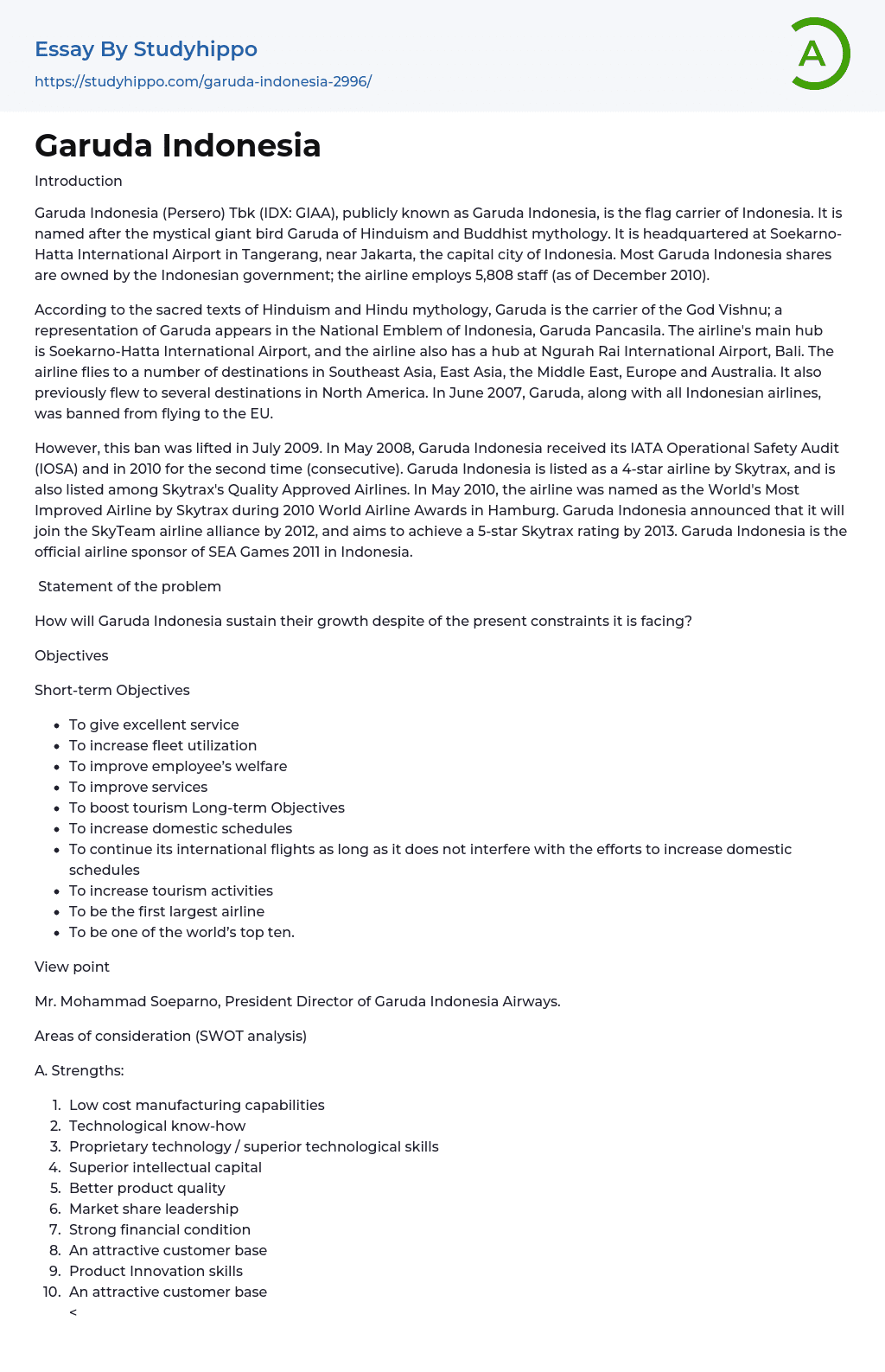Introduction
Garuda Indonesia (Persero) Tbk (IDX: GIAA), publicly known as Garuda Indonesia, is the flag carrier of Indonesia. It is named after the mystical giant bird Garuda of Hinduism and Buddhist mythology. It is headquartered at Soekarno-Hatta International Airport in Tangerang, near Jakarta, the capital city of Indonesia. Most Garuda Indonesia shares are owned by the Indonesian government; the airline employs 5,808 staff (as of December 2010).
According to the sacred texts of Hinduism and Hindu mythology, Garuda is the carrier of the God Vishnu; a representation of Garuda appears in the National Emblem of Indonesia, Garuda Pancasila. The airline's main hub is Soekarno-Hatta International Airport, and the airline also has a hub at Ngurah Rai International Airport, Bali. The airline flies to a number of destinations in Southeast Asia, East Asia, the Middle East, Europe and Australia. It also previously flew to several destinations in North America. In June 2007, Garuda, along with all Indonesian airlines, was banned fr
...om flying to the EU.
However, this ban was lifted in July 2009. In May 2008, Garuda Indonesia received its IATA Operational Safety Audit (IOSA) and in 2010 for the second time (consecutive). Garuda Indonesia is listed as a 4-star airline by Skytrax, and is also listed among Skytrax's Quality Approved Airlines. In May 2010, the airline was named as the World's Most Improved Airline by Skytrax during 2010 World Airline Awards in Hamburg. Garuda Indonesia announced that it will join the SkyTeam airline alliance by 2012, and aims to achieve a 5-star Skytrax rating by 2013. Garuda Indonesia is the official airline sponsor of SEA Games 2011 in Indonesia.
Statement of the problem
How will Garuda Indonesia sustain their growth despite of the present constraints it is facing?
Objectives
Short-term Objectives
- To give excellent service
- To increase fleet utilization
- To improve employee’s welfare
- To improve services
- To boost tourism Long-term Objectives
View point
Mr. Mohammad Soeparno, President Director of Garuda Indonesia Airways.
Areas of consideration (SWOT analysis)
A. Strengths:
- Low cost manufacturing capabilities
- Technological know-how
- Proprietary technology / superior technological skills
- Superior intellectual capital
- Better product quality
- Market share leadership
- Strong financial condition
- An attractive customer base
- Product Innovation skills
- An attractive customer base
- Reputation of good customer service
- Fruitful collaborative partnerships with suppliers and marketing allies
B. Weaknesses:
- Systems in all aspects: sales, preparation, flight, supervisory.
- The quality of preflight, in-flight, and post-flight services which are still low.
- The biggest international market segment is low yield.
- Spareparts and other aircraft equipment are still imported; this needs longer time.
- The company’s organization is still unsteady. This situation makes “organizational behavior” incompetent in supporting the company.
C. Opportunities:
- “Political will” of the government in tourism.
- As, BUMN, Garuda is based on UUD’45 article 33, paragraph 2.
- The still-abundant-available seat capacity
- Government Regulation on Tariff.
- The strengthening currency of the countries from where tourists come to Indonesia.
D. Threats:
- Protection from certain countries, especially in traffic rights.
- The development of the other means of transportation, especially for near-distance transportation.
- The more increasing competition.
- The uncertain economic situation.
- Technology development in aircraft, manufacture. As the result of this development, the old aircrafts are no longer economical enough to be marketed.
- Low-Cost Carrier essays
- Easyjet essays
- Auction essays
- Balanced Scorecard essays
- Business Plans essays
- Expense essays
- Income essays
- Net Income essays
- Security Guard essays
- Singapore Airlines essays
- Battle essays
- Intranet essays
- Maintenance essays
- Simulation essays
- Inn essays
- Cars essays
- Bicycle essays
- Rms Titanic essays
- Renault essays
- Truck essays
- chrysler essays
- The city essays
- Racing essays
- Airlines essays
- Airports essays
- Boeing essays
- Aviation essays
- Emergency Management essays
- Health Insurance essays
- Insurance essays
- Life Insurance essays
- Public Transport essays
- Transportation essays
- Accounting essays
- Andrew Carnegie essays
- Automation essays
- Business Cycle essays
- Business Intelligence essays
- Business Model essays
- Business Operations essays
- Business Software essays
- Cooperation essays
- Cooperative essays
- Corporate Social Responsibility essays
- Corporation essays
- Customer Relationship Management essays
- Family Business essays
- Franchising essays
- Harvard Business School essays
- Harvard university essays




